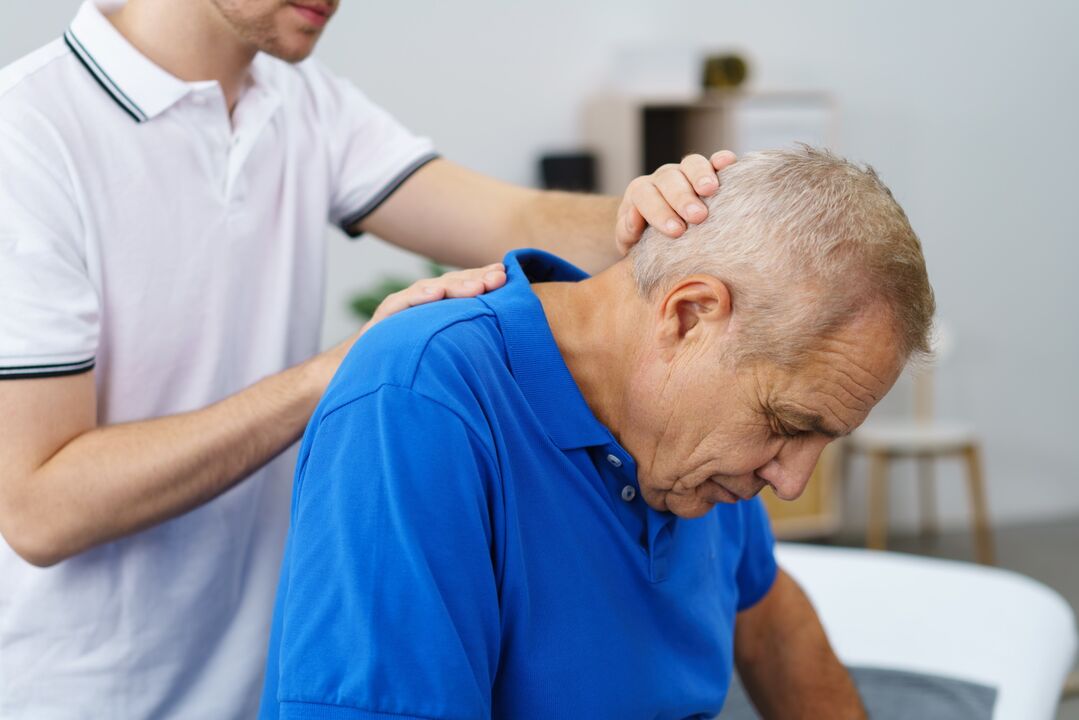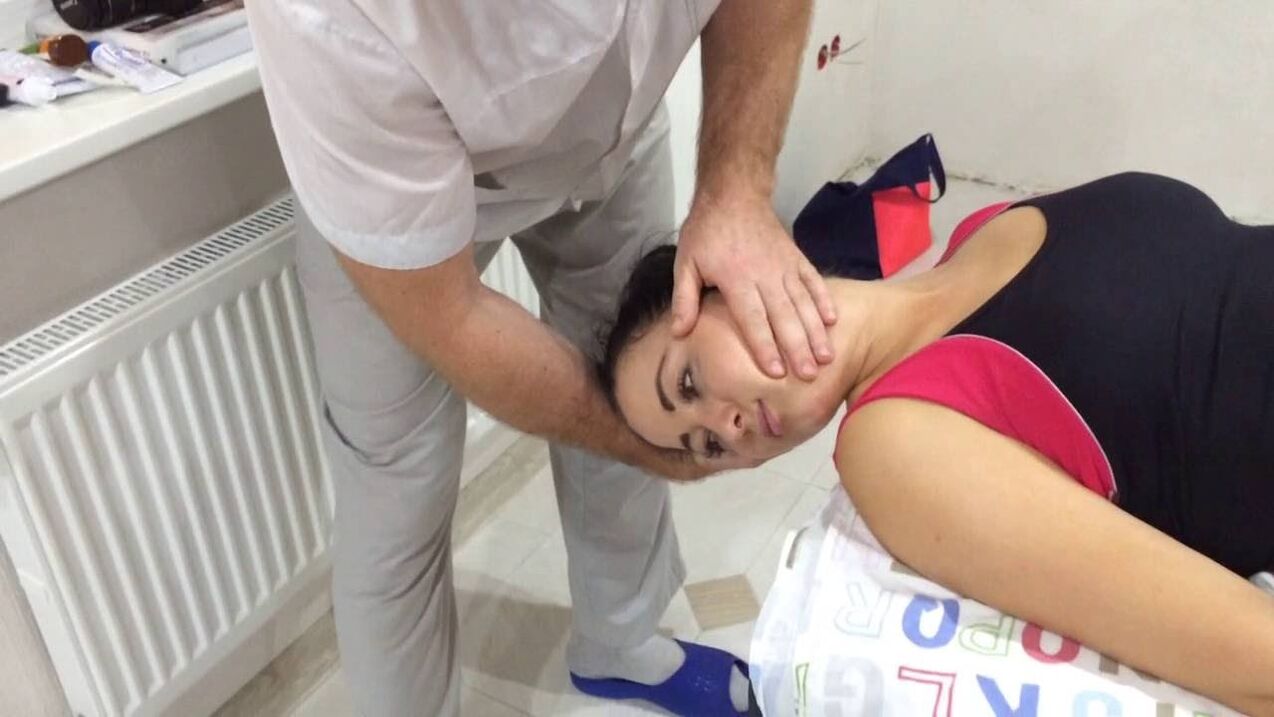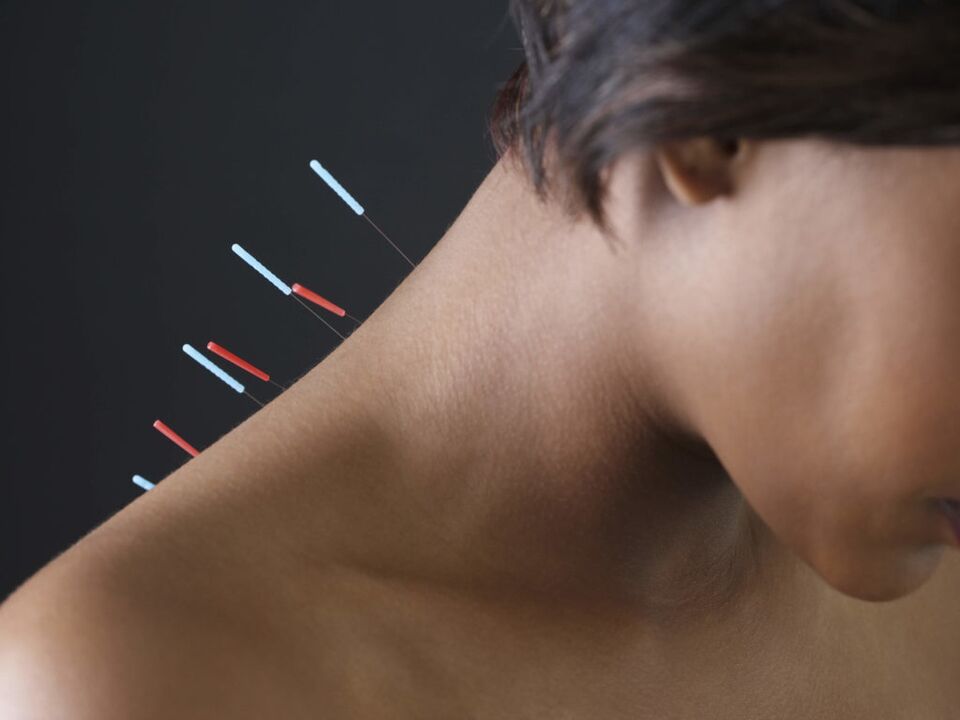
Osteochondrosis of the cervical spine is a pathological process in which the nutrition of the vertebral discs is disturbed, which leads to their gradual damage. With the further progression of the disease, the intervertebral discs lose their shape and cease to perform their main functions. The ability of the spine to withstand physical stress is lost.
Methods of Treatment
Effective treatment of cervical osteochondrosis consists of an integrated approach to the disease, combining drug therapy and physiotherapy. If these methods do not achieve a positive result, they resort to surgery.
Conservative treatment consists of taking non-steroidal anti-inflammatory drugs, vitamins, muscle relaxants. The former are designed to reduce inflammation and pain. If the pain is mild, topical ointments or gels will help. The use of vitamins helps improve blood circulation, which leads to better brain nutrition.
But any medication will not be enough when the cause of osteochondrosis lies in a person's lifestyle and remains unchanged. If the disease occurs from constant work at the computer, it is necessary to include some physical exercises in the work rhythm to warm up the neck.
Physiotherapy methods give good results:
- electrophoresis?
- Water procedures;
- massage;
- physiotherapy.

Significantly relieves discomfort with irudotherapy and manual therapy.
As a precaution during sedentary work, it is recommended to periodically perform self-massage, dispersing stagnant blood and providing an influx of nutrients to the brain. In addition, you should eat regularly, get enough rest at night and control your weight.
Osteochondrosis of the cervical spine is well corrected in the initial stages, before the onset of vertebral artery syndrome and cardalgia.
Treatment aims to eliminate pain, restore blood supply to the brain and slow the progression of the disease. The patient is treated by a neurologist. Conservative treatment is as follows:
- Applicationnon-steroidal anti-inflammatory drugslocal and systemic. Ointments, gels, tablets and injections cope well with pain in osteochondrosis.
- In the acute stage of the disease, accompanied by severe pain, it is usedparaspinal block- local administration of drugs (anesthetics and corticosteroids).
- Drug therapy is a combination of non-steroidal anti-inflammatory drugs, anticonvulsants,pain relievers and B vitamin complexes.
- With severe pain affecting the nervous and mental state of the patient, sedatives may be prescribed. With prolonged pain (more than 4 weeks), they are replacedantidepressants. These drugs allow you to stabilize the mental state of the patient.
- In the acute phase, it can be used to reduce compression of the nerve rootmuscle relaxants.
- It is prescribed to maintain cerebral circulationvasodilators, as well as means to improve metabolism in nervous tissue).
With the ineffectiveness of conservative treatment for several months and the progression of the disease, they sometimes resort to surgery.
Medical treatment
Drug treatment of osteochondrosis of the cervical spine involves the use of various drugs.
NSAIDs (NSAIDs)
Non-steroidal anti-inflammatory drugs (medications) are used as a symptomatic treatment, to relieve inflammation and eliminate pain at the time of exacerbation of the disease.
The course of taking NSAIDs for osteochondrosis of the cervical spine usually does not exceed 6 weeks. Medicines have only a symptomatic effect, and after the end of the course, the pain may return again. Often, NSAIDs are used in combination with antispasmodics, which help relieve muscle tension in the paraspinal zone.
Anesthetics
Pain and muscle tension are effectively eliminated with local anesthetics. Blockades are widely used by combining anesthetics with corticosteroid drugs, which, in addition to the analgesic effect, also have an anti-inflammatory effect.
As a local anesthetic, a solution is used, which includes substances that limit the flow of impulses to the irritated nerve endings and prevent its passage through the innervated areas.
hormones
Treatment with glucocorticosteroids can negatively affect the production of your own hormones. Therefore, modern medicine is much less likely than before to use drugs of this group in the treatment of cervical osteochondrosis and only if there are serious indications.
Hormonal drugs, when ingested, block the inflammatory process inside the cells.
Great!With prolonged use, glucocorticosteroids contribute to the destruction of cartilage, so they should be combined with chondroprotectors.
Medicines containing corticosteroids quickly relieve pain, but at the same time negatively affect many internal organs. The course of hormone therapy rarely lasts more than 7 days, since with longer use, bone loss and the development of osteoporosis are possible.
Local irritants
As a result of the destruction of the intervertebral discs, the displacement of the vertebrae and the inflammatory process, the vessels in the tissues of the body narrow. You can improve blood circulation with the help of warming, topically irritating ointments.
When you use such funds, due to the stimulation of nerve endings, the blood flow to the problem area increases, which helps to improve the tissue nutrition process. After applying the ointment, the treated area of the skin becomes red due to the active influx. Since such drugs have a tonic effect, it is recommended to use them during the day.
Of the warming ointments, the most popular product is made on the basis of nicotinic acid butoxyethyl ether. Alternatively, capsaicin and dimethyl sulfoxide ointments are used..
In addition to ointments, special pads impregnated with active substances are used as a local irritant. So, for example, the composition of the well-known pepper patch includes hot pepper extract, belladonna, lanolin oil. These ingredients have a stimulating effect, relieving muscle spasm and increasing local blood circulation. At the same time, the oxygen supply to the cells and tissues is accelerated, due to which the pain disappears.
Carboprotectors
There is an active debate surrounding these drugs. Not all doctors use chondroprotectants to treat osteochondrosis. These drugs contain glycosaminoglycans and chondroitin sulfates, which are the structural basis of the intervertebral discs. Chondroprotectants are believed to prevent destruction of the cartilage of the spine and articular surfaces.
The composition of such preparations may contain chondroic acid, mucopolysaccharides, animal cartilage, glycosaminoglycans, etc.
Report.Some experts believe that the effect of these drugs is insignificant, although it differs from the placebo effect, and the effect achieved is not comparable to their high price.
Preparations for improving blood microcirculation
This group of drugs promotes the expansion of blood vessels. Medicines improve blood microcirculation, eliminate the violation of venous outflow, normalize metabolic processes, stimulate regeneration and increase the frequency of nerve impulses. As a result, blood circulation normalizes, metabolic processes in soft tissues improve and the degree of their swelling decreases, brain activity is restored.
vitamins
With osteochondrosis, the attending physician can prescribe the intake of individual vitamins or vitamin complexes. Particular attention is usually paid to the B vitamins (B1, B6 and B12). Their intake enhances the nutrition of nerve fibers, supports metabolic processes in cartilage tissue and gives it elasticity, improves blood circulation and the functioning of the central nervous system, and stimulates metabolic processes.
In addition to B vitamins, the supply of ascorbic acid to the body is of utmost importance. With its regular intake, the process of bone and cartilage tissue regeneration is improved, toxins are eliminated and the processes of carbohydrate, protein and mineral metabolism are regulated. It may partially reduce the need for additional intake of vitamins B1, B2, A and E.
Surgery
It is indicated in the absence of a visible result in the treatment of the disease using conservative methods, as well as in the development of complications.
Indications for surgical treatment of cervical osteochondrosis:
- spinal stenosis, due to a herniated or bulging disc - a 'pinching' of the spinal cord and/or nerve roots, resulting in pain, cramps, weakness or numbness.
- cervical spondylolisthesis - a condition in which the vertebrae are displaced along the horizontal axis with each other, slip when moving and cause pressure on the nerve roots and spinal cord.
- disc herniation - depending on the severity of symptoms, the severity of the patient's condition and the effectiveness of conservative treatment.
Massage
Massage is one of the main methods of treatment. In this case, it is not only useful, but also a necessary procedure. First you need to take a professional course. To get the greatest result, it is desirable to carry out at least 10 sessions. With cervical osteochondrosis, massage can achieve the following results:
- pain relief and muscle spasm relief.
- reduction of swelling;
- muscular strengthening?
- restoration of normal tone.
- improving blood supply and nutrition to the intervertebral discs.
- increased conductivity of nerve impulses.
- improvement of metabolic processes.

After a professional lesson, you can perform simple tricks at home yourself. The peculiarity of the procedure for cervical osteochondrosis is the passive stretching of the muscles from the position of hypertension in combination with massage elements. It is necessary to apply the technique after warming up the spasmodic muscles with a bath, hot compress or kneading.
For self-massage, the same techniques are used as in the professional version. These are tapping, kneading, point tapping, tapping, rubbing. The massage is done with warm hands. Massage oil should be used to improve gliding. The sequence of the technique is as follows:
- caressing;
- pulverization;
- kneading;
- drilling.
Ending a self-massage session should also be stroking. It is important that there is no severe pain during the procedure.
Report.In addition to traditional massage for osteochondrosis of the cervical spine, some other techniques are used, for example, acupuncture or vacuum massage. In the second case, medical banks or special vacuum devices are used.
Massage is very useful for cervical osteochondrosis. However, there are some factors that are absolute contraindications:
- blood diseases;
- osteomyelitis;
- thrombosis;
- malignant or benign neoplasms.
- aneurysms;
- active stage of tuberculosis;
- the presence of many warts and moles on the body;
- spider veins on the back.
There are also temporary contraindications:
- heat;
- infectious diseases;
- worsening of chronic processes.
exercise therapy
If the disease has already developed and been diagnosed, the first step after the elimination of pain and neurological symptoms with the help of drug therapy is a course of physiotherapy, as an integral part of complex treatment. A moderate load on the neck muscles in recession contributes to the strengthening and formation of the muscular corset that supports the intervertebral discs.
The main way to prevent cervical osteochondrosis, as well as neck weakness, is to strengthen the neck muscles. This will help the therapeutic exercises. To get tangible results, you should do at least 2-3 exercises 2-3 times a day. Initial position - sitting with a straight back.
- Exercise number 1.Tilt your head slightly forward and place your hands on your forehead. Then press your palms to your forehead and without moving your neck, hold the position for 30 seconds.
- Exercise number 2.Tilt your head back and slowly twist left and right for 1 minute. This exercise improves blood flow in the veins.
- Exercise number 3.At the same time, raise your shoulders trying to bring them to your ears, and then lower them to their original position. Then alternate - one shoulder down, the other up. The total duration is 2 minutes.
- Exercise number 4.Bring your palms together above your head, extending your elbows out to the sides. Press your palms firmly together for 2-5 seconds, then relax your hands. Repeat 3 times.
- Exercise number 5.Make smooth tilts of the head forward - on exhalation, back - on inhalation (3 times).
The fitness complex ends with self-massage - rub the neck with rotating circular movements.

Manual therapy
It is a set of non-pharmaceutical therapeutic and diagnostic techniques aimed at eliminating certain diseases of the spine.
Report.Usually about 10 sessions are performed with an interval of 2 days. After the first operations, the patient may experience mild pain, which is considered normal. But if the pain does not subside in the future, you should stop the course. Constant pain indicates either low professionalism of a specialist, or an incorrect diagnosis.
At the first visit, an experienced osteopath always performs a diagnostic palpation of the cervical region. The doctor determines the most painful parts, assesses the condition of the muscle tissue and skin. The success of further treatment will depend on the correct examination.
The session begins with warming up the muscles and a light massage. The doctor then stretches the muscles, reducing spasms in the cervical region. At this stage, the patient should not feel pain. After that, the therapist goes directly to the manipulation.
This is the most painful part of the process. The doctor with enough effort presses the cervical vertebrae trying to push them back. Often during such manipulations, patients hear a frightening creak, but this is considered normal. At the end of the session, the chiropractor gives a relaxing massage.
Immediately after the session, sudden head movements, tilts and distortions should be avoided. If possible, it is better to lie down for half an hour.

Great!A doctor using manual therapy techniques must master them perfectly to exclude harm to the patient.
Acupuncture
Acupuncture affects the body in a specific area by inserting needles into biologically active points. In this case, a response occurs, expressed in the directed production of hormones that regulate metabolic processes and the state of immunity. Due to this, inflammatory processes are actively suppressed.
The treatment is effective for cervical osteochondrosis. Under the influence of the procedure, the blood vessels of the neck expand, blood flow improves, the flow of oxygen and nutrients to the brain increases, headaches, tinnitus, dizziness disappear and the flow of the anti-inflammatory hormone cortisol in the bloodstream increases.

Folk remedies
Traditional medicine has many recipes that can relieve the pain and unpleasant symptoms of cervical osteochondrosis. However, although these recipes relieve the condition, they do not eliminate the cause of the disease, so other measures cannot be overlooked.
Compresses and tinctures are the most popular remedies. They warm the muscles, improve blood circulation, relieve pain.
Recipe 1.A blend of lard, horse chestnut, turpentine, agave and vodka. Cooking method:
- 3 tablespoons of horse chestnut;
- 100 g of American agave;
- camphor oil - 50 ml;
- purified turpentine - 30 ml.
- vodka - 200 ml;
- unsalted lard - 50 grams.
Grind and mix the ingredients and then put in a dark place for 9 days. To use, apply a thin layer on brown bread and apply to a sore spot. If a burning sensation occurs, the compress is removed. After the discomfort subsides, you can repeat the procedure.
Recipe 2.Calendula tincture.
It is necessary to take a glass bottle, pour 50 g of calendula into it and pour a cup of camphor distillate. Then add a glass of cologne and a glass of vodka. Put the closed bottle in a dark place and let it stand for a few weeks. The resulting tincture is rubbed on the sore spot.
Osteochondrosis is easier to prevent than to cure. All achievements in the fight against the disease will be reduced to zero if the patient continues to follow the same lifestyle: moving little, not exercising, gaining excess weight. This can again lead to pathologies of the intervertebral discs and exacerbation of osteochondrosis.





































